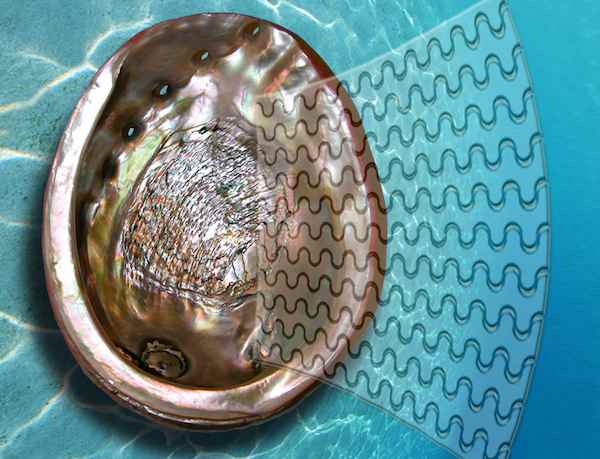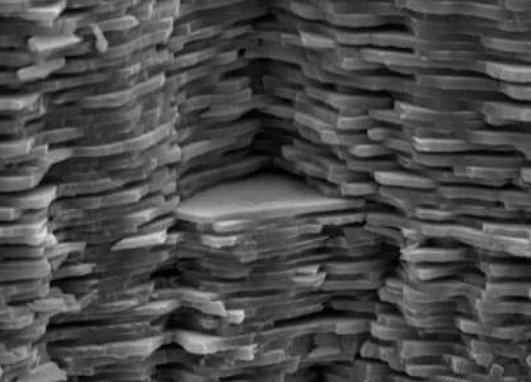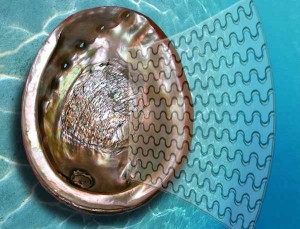
You know that shiny iridescent layer on the inside of some seashells? Did you ever wonder why it was there, other than to decorate the home of the mollusk that once called the shell home?

Scanning electron micrograph of nacre nanobricks.
Credit: F. Heinemann; Wikimedia Creative Commons License.
Turns out that pretty layer is called nacre, and it’s what makes seashells strong and durable. Nacre’s “work of fracture is 3,000 times greater than that of pure ceramic,” mostly because of its ingenious structure. It’s composed of a form of calcium carbonate called aragonite that is arranged in repetitive nanoscale bricks, like a tiny mason was commissioned to build each mollusk’s seashell home, nanobrick by nanobrick (see image to the right). Those bricks provide structure and stability, and they are separated by layers of elastic biopolymer that give the nacre flexibility and durability.
A new paper published in Nature Communications describes how nacre’s structure inspired a group of scientists from McGill University (Canada) to toughen up glass in a similar way.
The real secret behind the strength of nacre’s microstructure is its weaknesses. In nature, brittle materials that are nonetheless tough—including nacre and teeth—have stiff architectural building blocks with weak interfaces. The authors write in the paper, “The ability to guide and deflect cracks is fundamental to the performance of these materials, and it is only possible if the interfaces are weaker than the building blocks themselves.”
Nacre has inspired before. But previous attempts to built nacre-inspired materials from tiny building blocks have proven difficult. As senior author of the new study and McGill mechanical engineering professor François Barthelat said in the press release, “Imagine trying to build a Lego wall with microscopic building blocks. It’s not the easiest thing in the world.”
So instead of working from the bottom-up, the scientists built structures from the top-down: They mimicked those building blocks by introducing tiny prescribed cracks into an intact material. For the proof of principle, the authors looked to amorphous glass, “the archetype of a brittle material,” and used 3D laser engraving with a UV laser to inscribe controlled microcracks (i.e., structure) in borosilicate glass slides.
By creating straight microcracks in the glass, the scientists could guide how the glass cracked under stress. They then engineered microcrack designs that would prevent crack propagation by making it more difficult for the glass to break. Instead of straight microcracks, they created sets of squiggly lines that increased the strength of the glass 100 times over that of intact glass. They went even further to increase the strength another two-fold—200 times stronger than intact glass—by infiltrating the glass with polyurethane for cohesive strength during bending.

Undulating microcracks can strengthen glass, similarly to how nacre’s microstructure strengthens seashells.
Credit: McGill U.
Although inducing microcrack weaknesses in glass may seem counterintuitive to an effort to strengthen the material, the microcracks allow the glass to deform, preventing propagation of the cracks until a point of failure. As the authors describe in the paper, “The ability of stabilizing cracks is essential for damage and flaw tolerance, reliability and durability.” And although the scientists generated millimeter-sized features in the study, they also discuss the possible use of femtosecond lasers to generate micrometer and nanometer-sized features to tune materials to a desired strength and durability, depending on the application.
“What we know now is that we can toughen glass, or other materials, by using patterns of micro-cracks to guide larger cracks, and in the process absorb the energy from an impact,” Barthelat said in the press release. “We chose to work with glass because we wanted to work with the archetypal brittle material. But we plan to go on to work with ceramics and polymers in future. Observing the natural world can clearly lead to improved man-made designs.”
Barthelat confirmed in an email that his team is “currently experimenting with ceramics,” but we’ll have to wait for those results to learn more. I’ll keep you posted!
The paper is “Overcoming the Brittleness of Glass Through Bio-Inspiration and Micro-Architecture” (DOI: 10.1038/ncomms4166).
